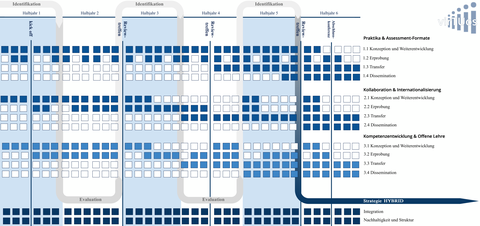4. project implementation
The course of the project follows four development steps in the areas of activity, which are followed by the two innovation teams: The areas of activity are to be synergistically recorded and addressed across subject cultures by coordinating and standardizing many existing hybrid solutions that have already been developed in decentralized islands, as well as further developing cross-disciplinary and cross-cultural concepts. Missing components may have to be redesigned and further developed. Through cross-departmental cooperation between the subject cultures, the further developed digitization concepts are tested so that the implementation experiences can be exchanged and fed back into further conceptual developments. Transfer: Locally tested and proven digitization concepts are to be established and transferred as standards, and the same applies to the content developed. The timely expansion of resources for the necessary scaling on a didactic and technical level must be ensured. Dissemination: Within the TUD, standardized and established digitization concepts are documented with the support of the external partners SLUB, DIU and CA/UKD and kept accessible in the long term and made known to a broad public outside the TUD as part of in-service and international academic study and certificate courses.

Abb. 4 (hochauflösende Version): Projektverlauf und -umsetzung mit Ausweisung der Handlungsfelder, Entwicklungsschritte und Meilensteine in den virTUos-Projekten.
In the course of the project (Fig. 4), the timelines resulting from the objectives and development steps are assigned to the areas of activity and the overarching HYBRID strategy. Agile and iterative work processes form the basis.
< back read more >
